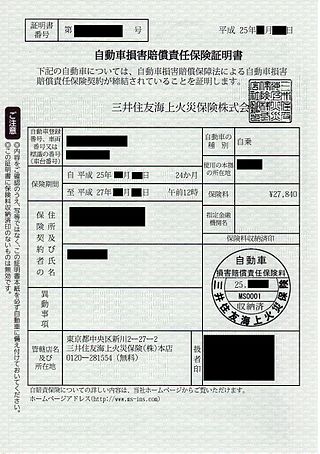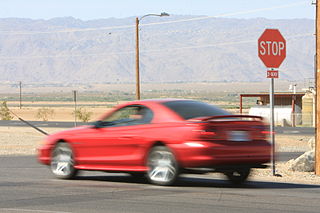Drunk driving is the act of operating a motor vehicle with the operator's ability to do so impaired as a result of alcohol consumption, or with a blood alcohol level in excess of the legal limit. For drivers 21 years or older, driving with a blood alcohol concentration (BAC) of 0.08% or higher is illegal. For drivers under 21 years old, the legal limit is lower, with state limits ranging from 0.00 to 0.02. Lower BAC limits apply when operating boats, airplanes, or commercial vehicles. Among other names, the criminal offense of drunk driving may be called driving under the influence (DUI), driving while intoxicated or impaired (DWI), operating [a] vehicle under the influence of alcohol (OVI), or operating while impaired (OWI).
The Georgia Electronic Insurance Compliance System or GEICS is a database of all motor vehicles and the current liability insurance carried by their drivers in the U.S. state of Georgia.

Driving under the influence (DUI) is the offense of driving, operating, or being in control of a vehicle while impaired by alcohol or drugs, to a level that renders the driver incapable of operating a motor vehicle safely. Multiple other terms are used for the offense in various jurisdictions.

A department of motor vehicles (DMV) is a government agency that administers motor vehicle registration and driver licensing. In countries with federal states such as in North America, these agencies are generally administered by subnational entities governments, while in unitary states such as many of those in Europe, DMVs are organized nationally by the central government.

Vehicle insurance is insurance for cars, trucks, motorcycles, and other road vehicles. Its primary use is to provide financial protection against physical damage or bodily injury resulting from traffic collisions and against liability that could also arise from incidents in a vehicle. Vehicle insurance may additionally offer financial protection against theft of the vehicle, and against damage to the vehicle sustained from events other than traffic collisions, such as vandalism, weather or natural disasters, and damage sustained by colliding with stationary objects. The specific terms of vehicle insurance vary with legal regulations in each region.

In the United States, a car dealership is a business that sells cars. A car dealership can either be a franchised dealership selling new and used cars, or a used car dealership, selling only used cars. In most cases, dealerships provide car maintenance and repair services as well as trade-in, leasing, and financing options for customers.

A moving violation or traffic violation is any violation of the law committed by the driver of a vehicle while it is in motion. The term "moving" distinguishes it from other motor vehicle violations, such as paperwork violations, parking violations, or equipment violations. The United States Department of State makes reference to moving violations in its enforcement guidance.

Defensive driving describes the practice of anticipating dangerous situations, despite adverse conditions or the mistakes of others when operating a motor vehicle. It can be achieved by adhering to general guidelines, such as keeping a two- or three-second gap between the driver's vehicle and the vehicle in front to ensure adequate space to stop. It is a form of training for drivers that goes beyond road rules and the basic mechanics of driving techniques. Defensive driving reduces the risk of collisions and improves road safety.

Automatic number-plate recognition is a technology that uses optical character recognition on images to read vehicle registration plates to create vehicle location data. It can use existing closed-circuit television, road-rule enforcement cameras, or cameras specifically designed for the task. ANPR is used by police forces around the world for law enforcement purposes, including checking if a vehicle is registered or licensed. It is also used for electronic toll collection on pay-per-use roads and as a method of cataloguing the movements of traffic, for example by highways agencies.
The American Association of Motor Vehicle Administrators (AAMVA) is a non-governmental, voluntary, tax-exempt, nonprofit educational association. AAMVA is a private corporation which strives to develop model programs in motor vehicle administration, police traffic services, and highway safety.

Driver's education, driver education, driving education, driver's training, driver's ed, driving tuition or driving lessons is a formal class or program that prepares a new driver to obtain a learner's permit or driver's license. The formal class program may also prepare existing license holders for an overseas license conversion or medical assessment driving test or refresher course. It may take place in a classroom, in a vehicle, online, or a combination of the above. Topics of instruction include traffic code or laws and vehicle operation. Typically, instruction will warn of dangerous conditions in driving such as road conditions, driver impairments, and hazardous weather. Instructional videos may also be shown, demonstrating proper driving strategies and the consequences for not observing the rules.
Many countries have adopted a penalty point or demerit point system under which a person’s driving license is revoked or suspended based on the number of points they’ve accumulated over a specific period of time. Points are given for traffic offenses or infringements committed by them in that period. The demerit points schemes of each jurisdiction varies. These demerit schemes are usually in addition to fines or other penalties which may be imposed for a particular offence or infringement, or after a prescribed number of points have been accumulated.

Motor vehicle registration is the registration of a motor vehicle with a government authority, either compulsory or otherwise. The purpose of motor vehicle registration is to establish a link between a vehicle and an owner or user of the vehicle. While almost all motor vehicles are uniquely identified by a vehicle identification number, only registered vehicles display a vehicle registration plate and carry a vehicle registration certificate. Motor vehicle registration is different from motor vehicle licensing and roadworthiness certification.
Auto insurance risk selection is the process by which vehicle insurers determine whether or not to insure an individual and what insurance premium to charge. Depending on the jurisdiction, the insurance premium can be either mandated by the government or determined by the insurance company in accordance to a framework of regulations set by the government. Often, the insurer will have more freedom to set the price on physical damage coverages than on mandatory liability coverages.

The California Department of Motor Vehicles (DMV) is the state agency that registers motor vehicles and boats and issues driver licenses in the U.S. state of California. It regulates new car dealers, commercial cargo carriers, private driving schools, and private traffic schools. The DMV works with the superior courts of California to promptly record convictions against driver licenses, and initiates administrative proceedings before its own administrative law judges to suspend or revoke licenses when drivers accumulate excessive convictions. It issues California license plates and driver's licenses. The DMV also issues identification cards to people who request one.

86 percent of people in the United States use private automobiles as their primary form of transportation to their workplace.

In the United States, driver's licenses are issued by each individual state, territory, and the District of Columbia rather than by the federal government due to federalism. Drivers are normally required to obtain a license from their state of residence. All states of the United States and provinces and territories of Canada recognize each other's licenses for non-resident age requirements. There are also licenses for motorcycle use. Generally, a minimum age of 15 is required to apply for a non-commercial driver license, and 25 for commercial licenses which drivers must have to operate vehicles that are too heavy for a non-commercial licensed driver or vehicles with at least 16 passengers or containing hazardous materials that require placards. A state may also suspend an individual's driving privilege within its borders for traffic violations. Many states share a common system of license classes, with some exceptions, e.g. commercial license classes are standardized by federal regulation at 49 CFR 383. Many driving permits and ID cards display small digits next to each data field. This is required by the American Association of Motor Vehicle Administrators' design standard and has been adopted by many US states. The AAMVA provides a standard for the design of driving permits and identification cards issued by its member jurisdictions, which include all 50 US states, the District of Columbia, and Canadian territories and provinces. The newest card design standard released is the 2020 AAMVA DL/ID Card Design Standard (CDS). The AAMVA standard generally follows part 1 and part 2 of ISO/IEC 18013-1. The ISO standard in turn specifies requirements for a card that is aligned with the UN Conventions on Road Traffic, namely the Geneva Convention on Road Traffic and the Vienna Convention on Road Traffic.
In the United States, an SR-22 is a vehicle liability insurance document required by most state departments of motor vehicles (DMV) offices for "high-risk" insurance policies. An SR-22 is not an insurance policy, but a filing, or an add-on, that is added to a personal automobile liability insurance policy. Not all insurance carriers offer SR-22 filings in all territories. For instance, an insurer may offer traditional base coverage in a particular state but not issue an SR-22 in that state.
The Driver's Privacy Protection Act of 1994, Title XXX of the Violent Crime Control and Law Enforcement Act, is a United States federal statute governing the privacy and disclosure of personal information gathered by state Departments of Motor Vehicles.
Vehicle insurance in the United States is designed to cover the risk of financial liability or the loss of a motor vehicle that the owner may face if their vehicle is involved in a collision that results in property or physical damage. Most states require a motor vehicle owner to carry some minimum level of liability insurance. States that do not require the vehicle owner to carry car insurance include New Hampshire and Mississippi, which offers vehicle owners the option to post cash bonds. The privileges and immunities clause of Article IV of the U.S. Constitution protects the rights of citizens in each respective state when traveling to another. A motor vehicle owner typically pays insurers a monthly or yearly fee, often called an insurance premium. The insurance premium a motor vehicle owner pays is usually determined by a variety of factors including the type of covered vehicle, marital status, credit score, whether the driver rents or owns a home, the age and gender of any covered drivers, their driving history, and the location where the vehicle is primarily driven and stored. Most insurance companies will increase insurance premium rates based on these factors and offer discounts less frequently.











